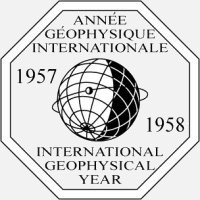eGY BackgroundThe International Geophysical Year, 1957-58The International Geophysical Year, IGY (1957-1958) grew out of the highly successful sequence of International Polar Years - the first in 1882/83 and the second 50 years IGY later in 1932/33.
IGY became a comprehensive global study of the geophysical phenomena and their relationships with solar activity. It aimed to make wide-spread, simultaneous, and intensive observations of a range of geophysical phenomena, using the latest instrumentation, rocket, and satellite technologies. About 60,000 scientists from 67 nations were involved, working at thousands of stations from pole to pole to obtain simultaneous, global observations on Earth and in space. IGY included studies of meteorology (large scale dynamic and thermodynamic processes), geophysics, the structure of the ionosphere, cosmic rays, solar activity (the Sun was more active in 1957-58 than in at any time in the previous 400 years), glaciology, seismology, and the Earth gravitational and magnetic fields. There had never been anything like it before. The IGY greatly expanded our knowledge about global processes, heralded the exploration of geospace, and left a legacy of monumental achievements:
It has been argued that the IGY led directly to the Antarctic Treaty, and the Global Atmospheric Research Programme (GARP - the predecessor to the present World Climate Research Program, WCRP) was a direct consequence of the success of the IGY. The base level of geophysical observations and research opportunities was broadened in many countries and a spirit of international cooperation and harmony was created despite a background of political tension. Estimates of the total cost of IGY in 1958 US dollars range from $200 million to $1000 million. References
A Sequel to IGYeGY coincides with the 50-year anniversary of the highly successful International Geophysical Year (IGY, 1957-1958). IGY, by inspiring and coordinating geoscientific programs worldwide and the establishing of a global network of observatories and World Data Centers, provided open access by the world community to vastly better and more comprehensive information about the Earth and geospace. By exploiting the power of modern communications and information management capabilities, eGY sets out to accomplish in 21st-Century terms what the IGY achieved 50 years ago. |
|

 These first and second IPYs involved predominantly Arctic activities. The Third International Polar Year, planned for 1957/58, was expanded in scope and became the IGY. This was proposed by ICSU in 1952 following a suggestion by Lloyd Berkner, a member of the US National Academy of Sciences. ICSU set up the Comite Spécial de l'Année Géophysique Internationale to plan and coordinate activities.
These first and second IPYs involved predominantly Arctic activities. The Third International Polar Year, planned for 1957/58, was expanded in scope and became the IGY. This was proposed by ICSU in 1952 following a suggestion by Lloyd Berkner, a member of the US National Academy of Sciences. ICSU set up the Comite Spécial de l'Année Géophysique Internationale to plan and coordinate activities.